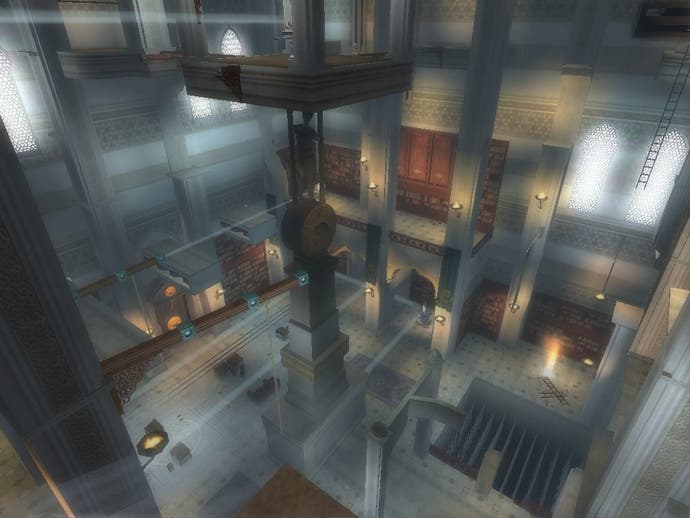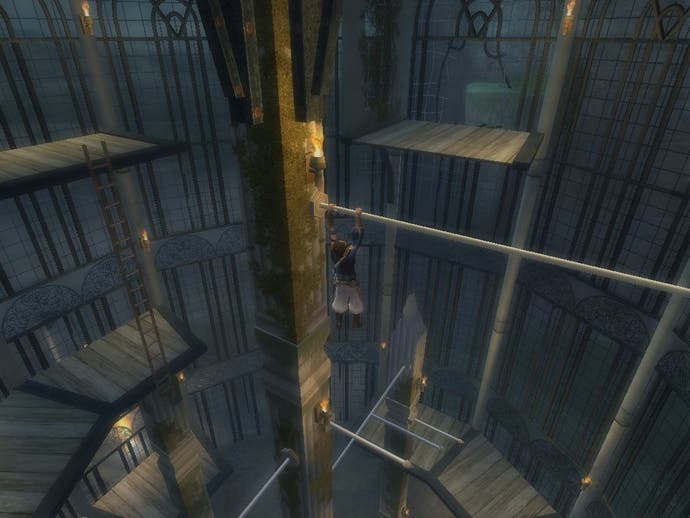Prince of Persia: The Sands of Time
Any excuse to play it again...
Picture the scene. You're playing a platform game - it doesn't matter which one - and you've been stuck on the same chunk of the same level for the best part of fifteen minutes. You know exactly what you need to do, but you keep fouling it up and having to start again. Your eyes are narrowed and your blood is simmering as you stab the Retry button for the fifth time in as many minutes. All of a sudden though, you're in the zone! Pixels are connecting precisely, the timing is perfect, your path is almost clear, and then, just as you gather enough momentum and leap victoriously towards the final platform, a scuttling rodent of an adversary wanders into your character's knees, and you stumble sideways into a bottomless pit. Continue? Quit? Or throw your pad across the room and scream blue murder at the cushions and the coffee table?
An ocean in a storm

Prince of Persia is different. As the young and courageous prince, you abandon your father's invading army to scour the treasure vaults of the conquered Maharajah's palace, hoping to secure honour and glory and a souvenir of your first battle. And that you do, in the shape of the Dagger of Time, a magical trinket so powerful that it can freeze and even rewind time to undo your mistakes. It's one of the most significant evolutions in platformers since Mario 64. But although the TV campaign might highlight the Dagger's potential to keep you happy at the expense of the game's other charms, it's the quality of the construction of the game itself for which Ubisoft Montreal deserves most praise. Prince of Persia is quite simply the most intuitive and dynamic platform adventure of the year.
Every room sees your fingers weave an acrobatic, death-defying pathway for the prince, as outlandish moves flow into one another effortlessly. In the first hour alone, you'll find yourself running on walls to leap to adjacent horizontal bars, only to turn around at the top of your swing and launch yourself diagonally upward at the wall again, using your momentum to fire yourself back off the rocky surface at another horizontal bar farther up, which happens to be within swinging distance of a series of crumbling pillars, which you can also leap between just by pointing and bashing the jump button. Later on you'll probably end up climbing along a series of narrow ledges, avoiding the crumbling ones and launching yourself backwards just in time to catch another surface, dodging sequences of rotating knives and spike pits along the way.
When you enter a complex room and the camera scans around, there's no anxiety at the task ahead, and there's no shame in mistakes. If you run along a wall, misjudge the distances and leap to your death, all you have to do is hold the rewind button to fly back through the air, run backwards along the wall and regain your footing on the ledge from whence you came. When you're safe, you stop holding rewind. Even better, the chances are you won't misjudge the distance in the first place, because Ubisoft Montreal has worked hard to eliminate unsatisfying failure altogether - moving the camera so you can line up tricky jumps at odd angles and even painting shadows on the wall so you know roughly where to jump.
Regal

It strikes the perfect balance - a few niggling sections aside, it's challenging without becoming frustrating, as the prince dances balletically across the crumbling palace of Azad, skimming along walls, swinging between chains, tiptoeing over narrow ledges and leaping between stalactites, all the while the palace's defence system snaps sharply at his heels. Mistakes are quickly rectified, and every exotic set-piece is gloriously simple to control, with the flow of the gameplay matched by some beautiful lighting effects. An iridescent humidity hangs in the air throughout, as the Sands of Time sparkle and cloud round the prince's ankles, veils flap in the wind, parting as he rushes past, and the environment trembles and crumbles to counter his progress. Object and model detail isn't anything especially fantastic, but the environments are vast and often beautiful - the menagerie, the guestrooms and the cavernous home of a life-affirming fountain are amongst the highlights - and the quality of the animations - particularly the transitions between each of the prince's fantastical moves - are delightfully seamless. And by the end of the game, you'll share the prince's feelings for the heroine, Farah, thanks to some extremely expressive voice acting and CG cut sequences.
Ah yes, Farah - slender, curvy, subtly beautiful and another key to Ubisoft's success. As the female lead, she begins at odds with our hero - who along with his father ransacked her palace, killed her father the Maharajah and brought her as a gift to the Sultan of Azad - but quickly develops an attachment to him, which is borne out in some detailed cut-scenes (admittedly a little grainy in the PC version) that capture the intensity and desperation of their relationship. Having built up the relationship literally on a knife's edge - Farah wants the Dagger of Time to undo the horrors unleashed on Azad by the Sands of Time, and the prince can never quite escape the conviction that she might steal it - the developer plays with them both throughout the latter sections of the game, before wrapping the story masterfully in one of the best end sequences of the year.
Kicking sand

While Prince of Persia is not without its faults, the sum of quality elsewhere completely overshadows them - and given that they would be seriously niggling issues in any other game, that's quite a statement. There are plenty of camera issues, including plenty of fixed perspective swapping between adjacent areas, which regularly sends you back and forward unnecessarily (something I definitely don't remember encountering this much in the PS2 version), and although the dagger effects are useful in battle, slowing and even halting proceedings so you can strike at will, by the end of the game I had slipped into a pattern that left me rather cold whenever faced with opposition.
The prince has plenty of moves at his disposal, many of which match his Tomb Raidering endeavours for sheer ingenuity - leaping over an enemy's head to strike him from behind, using the scenery to knock enemies down, backflipping and rolling away from sword blows, and parrying and thrusting like an accomplished swordsman - but his adversaries are disappointing, quickly broken down into a number of easily identifiable builds with simple weaknesses. Chain men can't block the over-the-head strike, swordsman have trouble with off-the-wall attacks, the bats always fly away before they're done, the vulture-like birds are just plain tedious and annoying, and the women are largely useless (sorry girls). Most enemies continuously respawn until the prince dispatches a certain untold number, at which point the game cuts to a face-to-face shot of him sheathing his weapons to indicate the bout is over.
Granted, it's nice to see the prince's acrobatic exploration matched by some balletic swordplay, his beautifully animated sword and knife slinging antics, including all manner of dagger thrusts to finish off enemies, but all in all the combat feels underdeveloped, a poor relation to the rest of the game, and quickly becomes tedious and repetitive. Fortunately it also becomes straightforward enough to battle through without much ceremony. It just feels like a pity that more time couldn't be spent with some of these encounters; particularly the game's boss fights, which are almost non-events. Indeed, although the 3D exploration and puzzles regularly draw comparison to ICO - and deservedly so - POP's conclusive battle was actually rather unconvincing, whereas ICO's final confrontation was an almost perfect finishing touch.
Just deserts

In the end though, it's all rather easily overlooked next to the sheer artistry of Ubisoft's accomplishment elsewhere. The Dagger of Time has given us a 3D platform experience almost entirely devoid of frustration, which anybody playing Jak II or Ratchet & Clank 2 right about now would probably kill for; the adventure is seamless and beautiful; the puzzles often pacey, always gigantic, but never less than logical; and almost every last detail is finely tuned. Save points are neatly spaced and coupled with sepia-tinted flash-forwards, which foreshadow key puzzle elements and gameplay additions like chain-swinging without actually giving away solutions; health is regained by sipping on a steady supply of water, a dangerous diversion during a battle with teleporting enemies, but a great way of keeping up the suspension of disbelief; the demented logic of the palace defence system, which seems to focus on you far more than your demonic adversaries, is discussed and analysed by the prince's narration, and a perfect excuse for the scale of the prince's task... It's difficult to think of anything that feels out of place.
Thankfully, when played on the PC, The Sands of Time looks and feels almost identical to its PS2 counterpart. The higher resolution is nice, but it doesn't make a huge impact in a game where an ICO-style scale, unusual lighting effects and free-flowing animation are the main technical triumphs. On the other hand, with the right sound system it does offer a Dolby Digital 5.1 environment, which will come in handy during one infuriating trial-and-error puzzle late on (you'll know the one I mean when you get to it).
Clearly well aware that the game's fluidity was at stake, Ubisoft has also taken to bundling a PS2 Dual Shock 2-alike gamepad from fellow Frenchies Thrustmaster. Although the exclusive Prince of Persia "design" on the pad is a damp squib (and the huge box is left rather empty when the pad takes up permanent residence on your desk), it's still the ideal way to play the game, and at £34.99 it's an "Exclusive Limited Edition" bundle that won't break the bank. Although you can play the game quite happily on the keyboard, you'll be much happier with a pad in hand - it's just a shame that the skill tutorials, which slot seamlessly into the first section of the game, can't be updated to talk about the buttons on the pad. For first time players, it's sure to be confusing without a list of inputs stuck to the side of the monitor.
Timeless
Although it hasn't always enjoyed sales to match, Ubisoft's Christmas 2003 line-up has been the strongest of any publisher - with games like XIII, Rainbow Six III and Beyond Good & Evil worthy of all manner of superlatives - but in the end it's Prince of Persia which stands tallest, and Crystal Dynamics had better take serious note if they aim to resurrect the Tomb Raider franchise in 2005. If there's one final thing that deserves a moment's consideration, it's that Ubisoft's peerless achievement is marred by a rather slight runtime of between seven and ten hours (in fact, having finished it on the PS2 earlier this month, this PC version took just five), but like ICO, it's a game that will live long in the memory, and needs to be played from time to time just to refresh the senses and reinvigorate the gamer inside us all. There's very little distance between this and a top score, and it's done more for Ubisoft Montreal's reputation than a dozen Splinter Cells.



